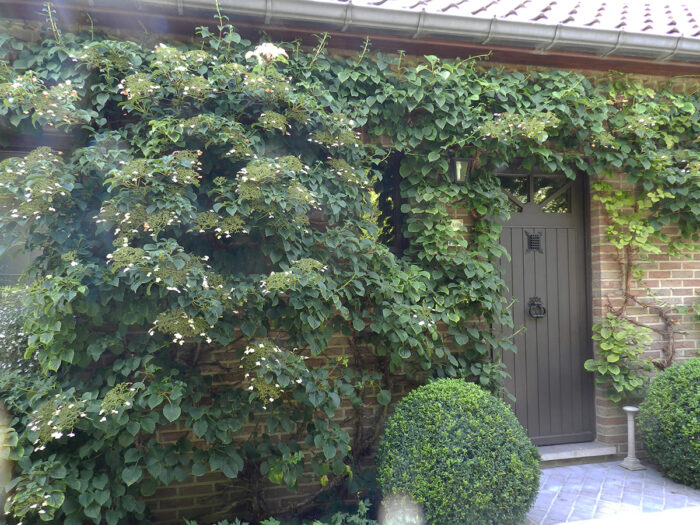
When you need a tall plant but don’t have a lot of room, a vine is the perfect solution. And when vines have fragrant flowers, they check off yet another box. Each of the following hardy, fragrant vines has its own personality and adds something unique to any garden design.

Five-leaf chocolate vine is a unique specimen with multiseason interest
Akebia quinata, Zones 4–9
Fragrance is one of the most desirable features a plant can have, and what scent would be more desirous than that of candy? Five-leaf chocolate vine has purple flowers that carry a subtle smell of chocolate. The flowers bloom in late spring and early summer, giving way to unique-looking and edible fruits. This vine is a robust grower with blue-green leaves that are similar in appearance to schefflera (Schefflera spp. and cvs., Zones 7–12). Flowering on old wood, it does best in full sun and soil with good drainage, although it tolerates conditions from moist to dry and can even grow in deep shade. Five-leaf chocolate vine enjoys a light application of a phosphorus-rich fertilizer or compost in the spring. Be sure not to overfeed, or you will find yourself with unmanageable growth in need of restraint. It will grow up to 60 feet tall if left unchecked, so cut it to the ground each spring, and prune lightly after flowering. This will help maintain a manageable size, as it can grow 10 to 20 feet annually. While this vine can be invasive in some areas, it doesn’t show the same tendency to spread into natural areas in the Northern Plains. Semi-evergreen in warm climates, it will die to the ground in our region. It makes a worthy choice for covering pergolas, fences, and tumbling over high walls.

Climbing hydrangea combines everything you love about hydrangeas in a slow-growing vine
Hydrangea anomala subsp. petiolaris, Zones 4–9
Perhaps one of the most elegant hardy vines for our region is climbing hydrangea. This vine has been a favorite of mine since I discovered it over 20 years ago. Beautiful white lacecap-hydrangea flowers bloom from late spring to early summer. The aerial roots provide support that enables it to reach heights up to 50 feet tall. Once the plant is established you can expect 12 inches or more of growth annually. Climbing hydrangea grows best in partial to full shade and is a low-maintenance plant with few problems. It prefers slightly acidic, well-drained soil that’s rich in nutrients. Apply a high-phosphorus fertilizer in spring and after blooming is finished. Like other hydrangeas, it appreciates consistently moist soil with 1 inch of water provided weekly—more when there is unseasonably hot or dry weather. Mulch to conserve moisture and cool the soil. When climbing hydrangea is properly cared for, you will be rewarded with stunning displays season after season.

Clematis is a remarkably diverse genus and a wildlife favorite
Clematis spp. and cvs., Zones 4–9
Known by many as the “Queen of the Vines,” clematis comes in almost every color except orange. With hundreds of varieties available, one can have an array of different clematis vines blooming from spring to fall with careful planning. The showy, fragrant flowers attract butterflies, hummingbirds, and bees, and the vines also provide habitat for nesting by various species of birds. When planting clematis, one should follow this simple rule: Plant with their heads in the sun and their feet in the shade. Clematis requires some support in order to climb, as it climbs by tendrils rather than the vine itself. Clematis are divided into three groups, each defined by its pruning requirements. All should receive a light spring cleanup to remove deadwood and debris.
Although I have only had marginal success with clematis in my own garden, I have many clients with stunning specimens. Perhaps the problem lies with the disrespectful creatures that inhabit my garden and continually break their slender stems. I am faced with a terrible choice: dogs or clematis? I guess I will stick with my dogs and plant clematis in another garden. However, the other two vines featured here are quite able to fend for themselves and withstand the abuse of large paws. Should you find one of these hardy vines to be a worthy addition to your garden, a little patience will reward you with a lush display of fragrant flowers every year.
—Marti Neely, FAPLD, owns and operates Marti Neely Design and Associates in Omaha, Nebraska.


















Comments
Log in or create an account to post a comment.
Sign up Log in